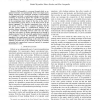Free Online Productivity Tools
i2Speak
i2Symbol
i2OCR
iTex2Img
iWeb2Print
iWeb2Shot
i2Type
iPdf2Split
iPdf2Merge
i2Bopomofo
i2Arabic
i2Style
i2Image
i2PDF
iLatex2Rtf
Sci2ools
ICRA
2008
IEEE
2008
IEEE
How morphology affects self-assembly in a stochastic modular robot
Abstract— Self-assembly is a process through which an organized structure can spontaneously form from simple parts. Taking inspiration from biological examples of self-assembly, we designed and built a water-based modular robotic system consisting of autonomous plastic tiles capable of aggregation on the surface of water. In this paper, we investigate the effect of the morphology (here: shape) of the tiles on the yield of the self-assembly process, that is, on the final amount of the desired aggregate. We describe experiments done with the real system as well as with a computer simulation thereof. We also present results of a mathematical analysis of the modular system based on chemical rate equations which point to a power-law relationship between yield rate and shape. Using the real system, we further demonstrate how through a single parameter (here: the externally applied electric potential) it is possible to control the self-assembly of propeller-like aggregates. Our results see...
| Added | 30 May 2010 |
| Updated | 30 May 2010 |
| Type | Conference |
| Year | 2008 |
| Where | ICRA |
| Authors | Shuhei Miyashita, Max Kessler, Marco Lungarella |
Comments (0)

